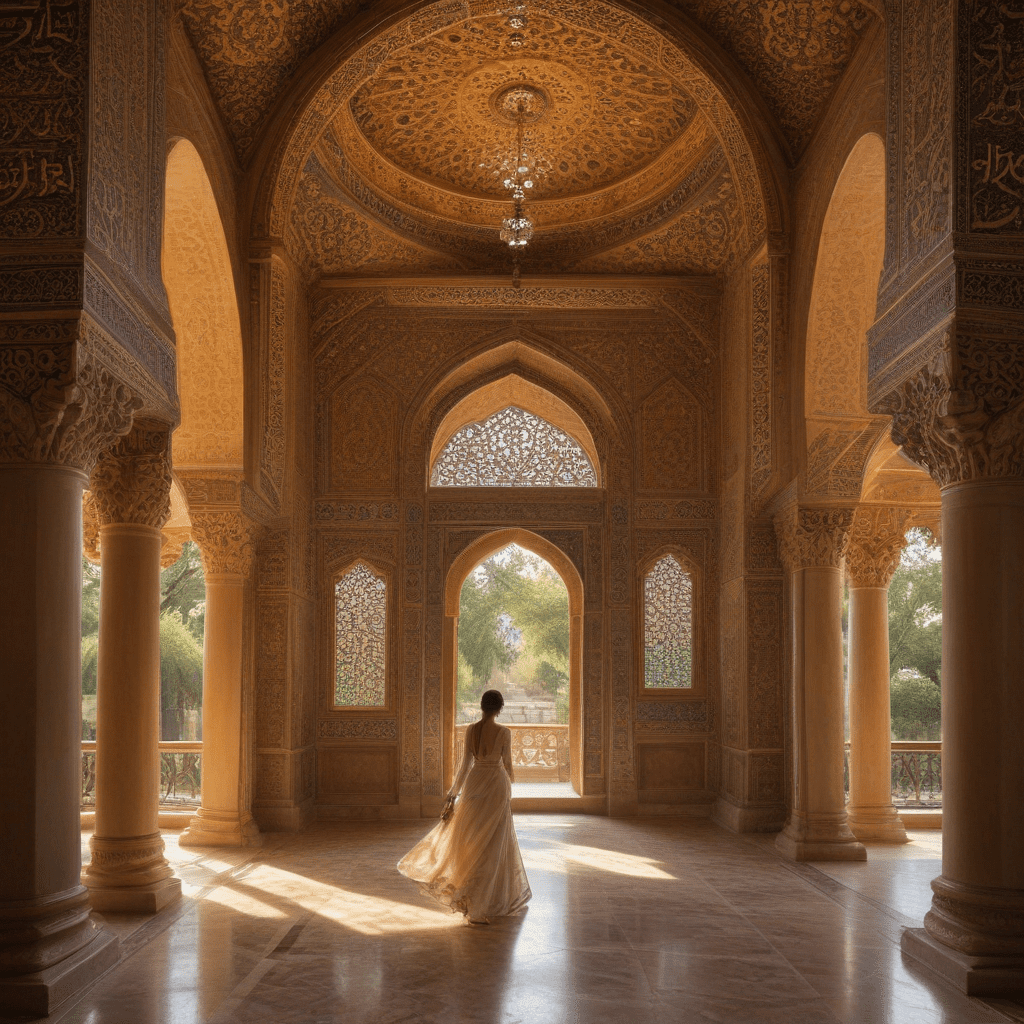1. Introduction
Persian Mythology: A Cultural Tapestry
Persian mythology, a rich tapestry of ancient beliefs, stories, and legends, has profoundly impacted various aspects of Persian culture, including architecture. This intricate relationship between myth and architecture is evident in design elements, symbolism, and cultural significance. From mythical creatures to symbolic representations, Persian architecture embodies a profound connection to its mythological heritage.
2. Mythological Influences on Design Elements
Mythical Creatures: Guardians of Design and Symbolism
The influence of mythical creatures like the Simurgh, a benevolent bird, and the dragon, a symbol of chaos, is evident in architectural elements like columns, capitals, and decorative motifs. These creatures often adorn palaces, tombs, and gardens, serving both aesthetic and symbolic purposes. The Simurgh, with its majestic wings and wise guidance, represents divine wisdom and protection, while the dragon embodies the forces of darkness and chaos. These mythical creatures not only enhance the visual appeal of architecture but also convey profound meanings, reflecting the cultural values and beliefs of ancient Persia.
3. Symbolic Representation in Architecture
Cypress Trees, Sun, and Lion: Symbols of Power and Divinity
Persian architecture is replete with symbolic elements like the cypress tree, the sun, and the lion. The cypress tree, with its tall and slender form, symbolizes immortality and eternal life. The sun, a source of light and warmth, represents divine power and cosmic order. The lion, a symbol of strength and royalty, is often depicted as guardians of palaces and temples. These symbols are not mere decorative elements but hold deep cultural significance, reflecting the beliefs and values of the ancient Persians. Each symbol carries a specific meaning, reflecting the reverence for nature, the belief in divine power, and the celebration of strength and courage.
4. Architectural Interpretation of Mythological Stories
Palaces, Tombs, and Gardens: Narratives in Stone and Nature
Many palaces, tombs, and gardens in Persia reflect mythological stories, serving as architectural interpretations of ancient narratives. The Shahnameh, an epic poem recounting the history and mythology of Persia, provides inspiration for many architectural structures. For instance, the Chehel Sotoun Palace in Isfahan features murals depicting scenes from the Shahnameh, bringing the epic tales to life through art and architecture. Similarly, the elaborate gardens of Persia often reflect the concept of paradise, as described in the Avesta, the sacred text of Zoroastrianism. These gardens, with their flowing water, lush greenery, and symmetrical layouts, evoke the mythical realm of Ahura Mazda, the supreme deity.
6. The Role of Gardens in Persian Mythology and Architecture
Paradise on Earth: Gardens as Symbols of Mythical and Cultural Ideals
Gardens hold a profound significance in Persian mythology and architecture, often associated with paradise and the concept of the "walled garden." These enclosed spaces, meticulously designed with flowing water, lush greenery, and fragrant flowers, evoke the mythical realm of Ahura Mazda, the supreme deity in Zoroastrianism. The Avesta, the sacred text of Zoroastrianism, describes paradise as a beautiful garden filled with light, joy, and abundance. This concept of paradise is reflected in the design of Persian gardens, creating earthly representations of the mythical ideal.
Beyond their symbolic association with paradise, Persian gardens also embody cultural values and beliefs. The careful planning, symmetry, and intricate water channels reflect the Zoroastrian emphasis on order, harmony, and purity. The presence of specific plants and flowers holds cultural significance, with roses symbolizing love and beauty, and cypress trees representing immortality. These gardens serve as microcosms of the Persian worldview, reflecting their connection to nature, their reverence for divine order, and their appreciation for beauty and harmony.
7. The Impact of Persian Mythology on Islamic Architecture
Mythological Echoes in Islamic Architectural Styles
Following the Islamic conquest, elements of Persian mythology were incorporated into Islamic architectural styles, demonstrating a fascinating adaptation and transformation. While Islamic art traditionally avoids figurative representations, mythological motifs were reinterpreted through geometric patterns, calligraphy, and abstract designs. The Simurgh, for instance, found expression in intricate arabesque patterns, symbolizing divine guidance and protection. Similarly, the cypress tree continued to be depicted in stylized forms, representing steadfastness and the connection between the earthly and the divine.
This integration of Persian mythology into Islamic architecture showcases a cultural exchange and artistic adaptation. While respecting Islamic principles, architects found ways to preserve the essence of ancient myths and symbols, reinterpreting them within the framework of new beliefs. This fusion resulted in a unique architectural style that reflects the rich cultural heritage of Persia and the evolving artistic expression of the Islamic world.
8. Cultural Significance of the Connection Between Persian Mythology and Architecture
A Legacy of Storytelling and Symbolism
The connection between Persian mythology and architecture is a testament to the enduring power of storytelling and symbolism. Through architectural elements, symbolic representations, and the interpretation of mythological narratives, ancient beliefs and values have been preserved and transmitted across generations. These structures serve as living testimonies to the rich cultural heritage of Persia, showcasing the intricate relationship between myth and reality, imagination and creation.
The fusion of mythology and architecture in Persia demonstrates the profound impact stories have on shaping the built environment. These narratives provide inspiration for design, imbue structures with symbolic meaning, and connect individuals to their cultural heritage. By understanding the connection between Persian mythology and architecture, we gain a deeper appreciation for the cultural richness and artistic ingenuity of this ancient civilization.
9. FAQs: Frequently Asked Questions
What are some examples of Persian architecture that reflect mythology?
The Chehel Sotoun Palace in Isfahan, with its murals depicting scenes from the Shahnameh, and the Fin Garden in Kashan, designed as a representation of paradise, are notable examples.
How did Zoroastrianism influence Persian architecture?
Zoroastrian principles of purity, duality, and cosmic order are reflected in the use of light, symmetry, and specific orientation in architectural design.
How did Islamic architecture adapt Persian mythology?
Figurative representations were replaced with geometric patterns, calligraphy, and abstract designs that alluded to mythological creatures and symbols.




